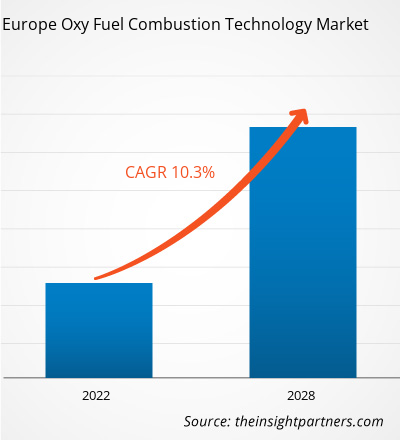The oxy fuel combustion technology market in Europe is expected to grow from US$ 123.71 million in 2021 to US$ 245.82 million by 2028; it is estimated to grow at a CAGR of 10.3% from 2021 to 2028.
Oxy fuel combustion is the process of combusting hydrocarbon fuel in a nearly pure oxygen environment, as opposed to air. Instead of using nitrogen to control the temperature, a part of the flue gas is used to dilute the oxygen. The primary goal of using oxy-fuel combustion in a coal-fired power plant is to produce flue gas with extremely high CO2 and water vapor concentrations, allowing the CO2 to be separated or captured from the flue gas using low-temperature dehydration and desulfurization processes. Reduced NOx emissions, high CO2 purity, and lower gas volumes due to increased density are just a few of the benefits of using oxy fuel combustion technology.Oxy-fuel combustion is one of the major methods available in the industry for cost-effective, technically feasible carbon capture. The most common oxy-fuel process involves pulverized coal being burned in an atmosphere of nearly pure oxygen (greater than 95% and up to 99%) mixed with recycled flue gas. Similarly, because oxygen is used for combustion and the re-burning mechanism through flue gas recycle, oxy-fuel combustion has the inherent advantage of producing low NOx emissions compared to most other combustion technologies.Thus, the reduction in emission of industrial gases such as carbon dioxide and nitrous oxide is influencing the adoption of oxy fuel combustion technology among various industries such as manufacturing, metal and mining, oil & gas, and power generation, thereby contributing to the growth of the market.
Europe witnessed a varying impact of the COVID-19 pandemic across its economically diverse countries. For instance, governments of countries such as Germany, the UK, the Netherlands, and France imposed stringent restrictions and closed their borders to curb the virus spread. Additionally, countries such as Italy, Russia, and Spain witnessed a significant surge in cases, which led them to shut down business and manufacturing operations for a few months. However, several European countries witnessed swift recovery from the third quarter of 2020. Irrespective of surge in the number of COVID cases and shutdown of business operations for months, manufacturers had to continue the production of essential goods or resume it earlier than other businesses. Oxy fuel combustion systems are necessary in waste disposal and power generation industries, these businesses generated a stable demand for these systems. The oxy fuel combustion system production plants were operating under strict COVID-19 guidelines. However, the lowered demand for other industrial areas such as glass production, metal production, and coating and spraying, affected the overall cash flow of oxy fuel combustion technology providers.
With the new features and technologies, vendors can attract new customers and expand their footprints in emerging markets. This factor is likely to drive the Europe oxy fuel combustion technology market. The Europe oxy fuel combustion technology market is expected to grow at a good CAGR during the forecast period.
Europe Oxy Fuel Combustion TechnologyMarket Revenue and Forecast to 2028 (US$ Million)
- This FREE sample will include data analysis, ranging from market trends to estimates and forecasts.
Europe Oxy Fuel Combustion Technology Market Segmentation
Europe Oxy Fuel Combustion Technology Market – By Offerings
- Solution
- Services
Europe Oxy Fuel Combustion Technology Market – By End-Use Industry
- Oil & Gas
- Power Generation
- Manufacturing
- Metal & Mining
- Others
Europe Oxy Fuel Combustion Technology Market, by Country
- France
- Germany
- Italy
- UK
- Russia
- Rest of Europe
Europe Oxy Fuel Combustion Technology Market - Companies Mentioned
- Air Liquide SA
- Air Products and Chemicals, Inc.
- ESA S.P.A.
- FALORNI GIANFRANCO S.R.L
- General electric Company
- HEIDELBERGCEMENT AG
- Hitachi, Ltd.
- Jupiter Oxygen Corporation
- LINDE
Europe Oxy Fuel Combustion Technology Report Scope
| Report Attribute | Details |
|---|---|
| Market size in 2021 | US$ 123.71 Million |
| Market Size by 2028 | US$ 245.82 Million |
| Global CAGR (2021 - 2028) | 10.3% |
| Historical Data | 2019-2020 |
| Forecast period | 2022-2028 |
| Segments Covered |
By Offerings
|
| Regions and Countries Covered | Europe
|
| Market leaders and key company profiles |
- Historical Analysis (2 Years), Base Year, Forecast (7 Years) with CAGR
- PEST and SWOT Analysis
- Market Size Value / Volume - Global, Regional, Country
- Industry and Competitive Landscape
- Excel Dataset



Report Coverage
Revenue forecast, Company Analysis, Industry landscape, Growth factors, and Trends

Segment Covered
This text is related
to segments covered.

Regional Scope
North America, Europe, Asia Pacific, Middle East & Africa, South & Central America

Country Scope
This text is related
to country scope.
Trends and growth analysis reports related to Energy and Power : READ MORE..
- Air Liquide SA
- Air Products and Chemicals, Inc.
- ESA S.P.A.
- FALORNI GIANFRANCO S.R.L
- General electric Company
- HEIDELBERGCEMENT AG
- Hitachi, Ltd.
- Jupiter Oxygen Corporation
- LINDE

 Get Free Sample For
Get Free Sample For